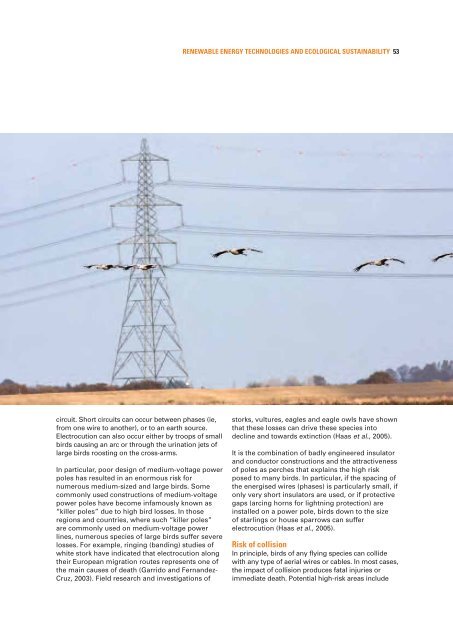Meeting Europe's renewable energy targets in harmony with - RSPB
Meeting Europe's renewable energy targets in harmony with - RSPB
Meeting Europe's renewable energy targets in harmony with - RSPB
Create successful ePaper yourself
Turn your PDF publications into a flip-book with our unique Google optimized e-Paper software.
RENEWABLE ENERGY TECHNOLOGIES AND ECOLOGICAL SUSTAINABILITY 53<br />
circuit. Short circuits can occur between phases (ie,<br />
from one wire to another), or to an earth source.<br />
Electrocution can also occur either by troops of small<br />
birds caus<strong>in</strong>g an arc or through the ur<strong>in</strong>ation jets of<br />
large birds roost<strong>in</strong>g on the cross-arms.<br />
In particular, poor design of medium-voltage power<br />
poles has resulted <strong>in</strong> an enormous risk for<br />
numerous medium-sized and large birds. Some<br />
commonly used constructions of medium-voltage<br />
power poles have become <strong>in</strong>famously known as<br />
“killer poles” due to high bird losses. In those<br />
regions and countries, where such “killer poles”<br />
are commonly used on medium-voltage power<br />
l<strong>in</strong>es, numerous species of large birds suffer severe<br />
losses. For example, r<strong>in</strong>g<strong>in</strong>g (band<strong>in</strong>g) studies of<br />
white stork have <strong>in</strong>dicated that electrocution along<br />
their European migration routes represents one of<br />
the ma<strong>in</strong> causes of death (Garrido and Fernandez-<br />
Cruz, 2003). Field research and <strong>in</strong>vestigations of<br />
storks, vultures, eagles and eagle owls have shown<br />
that these losses can drive these species <strong>in</strong>to<br />
decl<strong>in</strong>e and towards ext<strong>in</strong>ction (Haas et al., 2005).<br />
It is the comb<strong>in</strong>ation of badly eng<strong>in</strong>eered <strong>in</strong>sulator<br />
and conductor constructions and the attractiveness<br />
of poles as perches that expla<strong>in</strong>s the high risk<br />
posed to many birds. In particular, if the spac<strong>in</strong>g of<br />
the energised wires (phases) is particularly small, if<br />
only very short <strong>in</strong>sulators are used, or if protective<br />
gaps (arc<strong>in</strong>g horns for lightn<strong>in</strong>g protection) are<br />
<strong>in</strong>stalled on a power pole, birds down to the size<br />
of starl<strong>in</strong>gs or house sparrows can suffer<br />
electrocution (Haas et al., 2005).<br />
Risk of collision<br />
In pr<strong>in</strong>ciple, birds of any fly<strong>in</strong>g species can collide<br />
<strong>with</strong> any type of aerial wires or cables. In most cases,<br />
the impact of collision produces fatal <strong>in</strong>juries or<br />
immediate death. Potential high-risk areas <strong>in</strong>clude
















